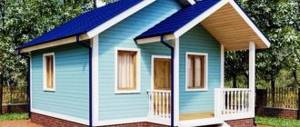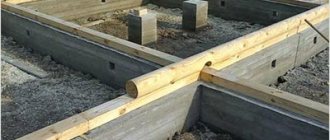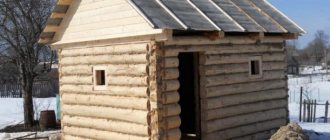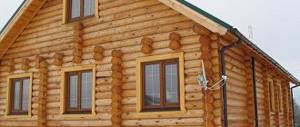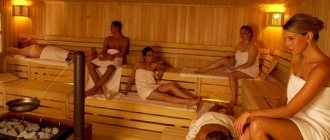Is it possible to build a bathhouse from aerated block?
Aerated concrete is cellular concrete with high porosity and the ability to absorb moisture. Therefore, for a long time it was believed that gas block was not the most suitable material for building a sauna. But the advantages of aerated concrete outweighed its disadvantages, and today not only small family bathhouses on private plots, but also large two-story bathhouse complexes are built from aerated concrete blocks. Of course, during construction, all operational features of aerated concrete are taken into account:
- The gas block easily absorbs moisture, and it is difficult to dry the room. The problem can be solved very simply: by providing good ventilation. The easiest way is to choose a bathhouse design that has large windows located opposite each other. After washing, just open the windows and the room will quickly dry out in a draft. In this way, both a small sauna and a large aerated concrete bathhouse 6 by 6 meters can be dried.
- In a bathhouse made of aerated concrete there will be no characteristic woody smell. Indeed, when heated, a gas block will not smell like natural timber, but interior wood trim will help give the sauna a “woody” feel. Both chamber-drying timber and inexpensive lining are suitable for this. A gap of 5-10 cm must be left between the gas-block wall and the wooden finish for ventilation. This should be taken into account when choosing a project. For example, the useful area of a 4 x 3 bathhouse made of aerated block will be 15% smaller due to the gap arrangement.
- Need for waterproofing. Considering that we are talking about rooms with high humidity, it will be necessary to do effective waterproofing between the foundation and the walls, between the floors (if a two-story bathhouse project is chosen), between the roof and the walls. The durability of the structure will depend on the quality of waterproofing. Two undeniable arguments can be made here. First: even if the bathhouse was built from moisture-resistant brick, you would still have to do waterproofing. Second: a turnkey bathhouse made of aerated concrete, even with the most expensive waterproofing, will be much cheaper than one made of timber or brick.
Expert opinion Vitaly Kudryashov builder, aspiring author
Ask a Question
So, we can conclude that, like a residential building, a bathhouse made of aerated concrete is a reality. All existing shortcomings of this material can be easily eliminated with the right approach to construction.
We combine a house with a garage and a bathhouse
If you are planning to build a house with a bathhouse and a garage, then first of all you should think about the choice of material.
The fact is that this is partly an attempt to “combine the incompatible,” because these premises not only have different purposes, but are also quite specific:
- In the bathhouse there are high temperatures and frequent temperature changes, not to mention high humidity, which can quickly deteriorate the design of upholstered furniture and interior decoration, etc. Therefore, the bathhouse interior is strict and consists of wooden furniture, and the walls are most often lined clapboard. Taking into account all the features described above, for a bathhouse combined with a garage and a residential building, it will be necessary to ensure reliable waterproofing. In addition, when arranging baths, you cannot use materials that emit harmful substances when burned.
The bathhouse should be lined with wood.
- The garage space is most often intended not only for storing a car. It is also a storage room where building materials, gasoline, engine oil and various tools are stored. Therefore, it is necessary to use the most durable, wear-resistant and easy-to-clean coatings.
- Living rooms should be environmentally friendly. Therefore, first of all, the layout of the site for a house with a garage, bathhouse and gazebo should take into account the fact that moisture and heat from the bathhouse and the smell of oil and gasoline from the garage should not penetrate into the living rooms.
As you can see, the requirements are quite different, but such structures should be built from the same material, so it is necessary to choose a building material that would satisfy the requirements of each part of the building.
Advice! To save space on the site, the steam room can be placed on the first floor, and living rooms on the second.
Material selection
When developing a house project along with a garage and a bathhouse, you should pay attention to the following materials:
- Wood is the best material for a bathhouse. In addition, traditional houses in Rus' were chopped and built from logs. However, wood is not the best option for a garage. The problem is that in the garage the walls, just like other surfaces, get dirty very quickly, losing their appearance.
Advice! The problem with the garage space can be solved by interior finishing of wooden walls. Plastic is perfect for this, as it has a presentable appearance and is easy to clean.
The photo shows a brick house with a garage and bathhouse extension.
- Brick is a more reliable and practical material for garage construction. It is also excellent for the construction of residential buildings, being the main building material in this industry. Brick is also suitable for baths, but in this case you should carry out additional insulation of the walls. A house project with a garage and a brick bathhouse will require a more massive foundation and wall finishing, which significantly increases the price of the building. In addition, the material itself is not cheap.
- If you want to save money, you can build a house with a sauna and a garage with your own hands from foam concrete, slag concrete or expanded clay concrete. These materials are an excellent alternative to brick because they are cheaper and larger in size, which can significantly speed up the construction process.
Design Features
Plan of a building in which the bathhouse and garage are on the first floor, and living rooms are on the second.
Before placing a garage, bathhouse and house on your site, you should consider some points.
The following instructions will help you in designing:
- To extend the life of the building you need to carry out high-quality waterproofing. This is very important for both the bathhouse and the garage. The fact is that high humidity, exhaust gases and aggressive liquids will negatively affect the integrity of the foundation.
- All adjacent walls between the bathhouse and the rest of the building must be properly insulated. If the thermal insulation is insufficient, this can lead to rupture of the wall seam.
- It is advisable to locate the garage and bathhouse nearby. It would also be a good idea to install a door between them. This way you can store sauna fuel in the garage, and, if necessary, deliver it to the sauna.
- Also, the door between the bathhouse and the shower will come in handy after doing dirty garage work. You can take a warm shower without leaving the room.
- The sauna stove can be installed against an adjacent wall. This way you will save on heating your living space.
A project in which a residential building is located between a bathhouse and a garage.
Advantages of aerated concrete baths
Now let’s look at the advantages of building turnkey aerated concrete baths:
- Projects and prices. The construction of even a large aerated concrete bathhouse with a terrace, enclosed veranda or attic will not be burdensome on the budget. Prices for standard projects start from 5,000 rubles, and in some cases the project can be obtained for free.
- Heating rate. Aerated concrete blocks heat up quickly and retain heat well. You can heat a gas-block steam room in a couple of hours, while heating a brick sauna takes 6-7 hours.
- Resistant to mold and rot. Wooden saunas suffer from these “illnesses”. The gas block is not susceptible to rotting and mold, so you don’t have to worry about a healthy microclimate.
- Light weight. Aerated concrete blocks are a lightweight material, so the structure does not need a reinforced foundation. For a small 3 by 3 bathhouse made of aerated concrete, you can use a non-buried concrete strip only 20 cm wide as a base.
- Non-flammable and environmentally friendly. The presence of a stove requires special fire safety measures. Aerated concrete is a non-flammable material that is resistant to fire and prevents its spread. When heated, the blocks do not release toxins.
Aerated concrete bath projects
A bathhouse or sauna is a standard structure, so owners rarely order an individual design, but choose a faster and more affordable option - a standard turnkey aerated concrete bathhouse project, the price of which starts from 5-6 thousand rubles. The project contains architectural and design solutions, information about the object: area, materials, layout, drawings. An obligatory part of the design documentation is an estimate, which describes in detail what the final cost of the structure consists of.
We suggest considering several universal projects for an aerated concrete bathhouse located near the house:
Small sauna up to 20 m²
A compact 4 by 4 bathhouse made of aerated concrete is suitable for a small area. The structure is designed for 4-5 people. The steam room in such a bathhouse is small - no more than 25% of the total area, another 25% is occupied by the shower and washing room (room for storing equipment). The rest room is combined with a dressing room. In some cases, this is inconvenient, so you can consider a 5 by 3 bathhouse project made of aerated concrete. Such a structure will have a rectangular shape, so the rooms will be located one after another: room - dressing room - steam room.
Standard bathhouse made of aerated block 6 by 6
A large building that can comfortably accommodate a company of 8-10 people. Often, having the opportunity to build a large building, future owners choose a bathhouse project made of aerated concrete with a terrace or open veranda on which a barbecue or barbecue is installed. The design of a 6x6 bathhouse made of aerated concrete, in addition to a steam room, shower and dressing room, may include a separate room with a shower, jacuzzi or even a bedroom where you can relax after water treatments. Having the opportunity to make a large building, you should not limit yourself to a standard 6 by 6 meter aerated concrete bathhouse project. Consider options with other sizes. For example, a 6 by 4 bathhouse made of aerated block will be more preferable for a rectangular area.
Bathhouse 6 by 3 made of aerated concrete on 2 floors
A two-story sauna with an attic made of aerated concrete is already a full-fledged recreation center. On the ground floor there is a spacious steam room, a dressing room, a wardrobe that can be divided into male and female parts, showers, a jacuzzi, and a swimming pool. This is exactly the design of a 5x7 aerated concrete bathhouse on 2 floors that should be considered by those who want to equip several recreation rooms. Recreation areas are located on the attic floor. This could be one living room plus one bedroom or several separate bedrooms.
One-story baths
A typical design for an inexpensive and practical wooden bathhouse with an area of about 20 sq.m provides for a steam room, a washing room (or a combination of the functions of these rooms) and a dressing room.
A terrace or glazed veranda will expand the functionality of a one-story building. Terraces with an area of 6-8 sq.m. often included in projects of both more spacious and very small baths. A table and several wicker chairs can easily fit here for relaxing in the fresh air. A veranda is more practical than a terrace because it can be used in all weather conditions.
Project selection
When choosing a project for a bathhouse made of aerated concrete with a relaxation room, a terrace or for a modest sauna 4x4 meters, consider the following:
- The minimum area for 1 person is 2 m², the optimal is 3-4 m².
- When calculating the area, take into account the thickness of the gap between the gas block wall and the wooden cladding.
- It is better if the shape of the structure follows the configuration of the site.
- The presence and location of windows, doors, installation location of the stove, plumbing.
- If a boiler is used for heating, the design must include a boiler room.
- The stove must be located so that an efficient and safe chimney can be organized.
Expert opinion Vitaly Kudryashov builder, aspiring author
Ask a Question
The construction of turnkey aerated concrete baths and projects at prices affordable for ordinary consumers are offered today by many companies. Even if you decide to build a bath structure yourself, it is better to take a standard project that has passed a technical and fire examination.
How to build a bathhouse from aerated concrete
Construction can begin after the design of the aerated concrete bathhouse has been selected and the drawings and estimates are ready. If the selected project does not have a drawing of any node, it can be found on the Internet. It will be free, but we cannot guarantee its correctness. For example, consider the construction of a bathhouse made of aerated concrete according to a 4x6 meter project.
Materials, tools, drawings
The exact name of materials, their quantity and cost are indicated in the estimate, which is a mandatory part of the project. The materials you will need are concrete for pouring the foundation, waterproofing, vapor barrier, aerated concrete blocks, timber for the rafter system, window blocks, assembled doors, roofing, materials for external and internal finishing. As a rule, the estimate includes about 50-80 items. The tools you will need are a concrete mixer, tools for laying blocks and woodworking, and painting tools.
Drawings that you must have on hand before starting construction:
- floor plan + section;
- layout plan;
- connecting the foundation to the wall and installing the floor;
- method of laying and strengthening openings;
- installation of an insulated roof;
Foundation
For aerated concrete buildings, a strip foundation is erected on stable soils; on unstable soils, a pile-screw foundation with a reinforced concrete or metal grillage is erected. Type of strip base - shallow or shallow. Monolithic tape is made by pouring concrete mixture into prepared formwork. If it is impossible to wait until the concrete gains strength (28 days), you can lay the foundation from brick or rubble.
Walling
A 6x3 bathhouse made of aerated concrete with a wall thickness of 250 mm is a purely summer option. If you plan to use the structure year-round, then the thickness should be at least 400 mm. In the northern regions - at least 600 mm. For masonry, only a heat-insulating adhesive mixture is used. The use of cement mortar is unacceptable.
Roof
The roof must be light, fireproof and warm. The rafter system is traditionally made of wood. Effective waterproofing and insulation of the roof is mandatory. It is recommended to use polymeric materials such as “flexible tiles” as a roofing covering. They are more resistant to moisture than ondulin or metal tiles.
Disadvantages of combined construction
Despite a large number of advantages, house designs with a bathhouse and a garage have obvious disadvantages:
- High level of fire danger. The first and most significant drawback that frightens owners is the risk of fire when placing a bathhouse in such a house concept. The bathhouse is an object of increased fire danger. If the bathhouse catches fire, the risk of losing the entire house is enormous. It is for this reason that the construction of a bathhouse has always been carried out as far as possible from living quarters. Modern materials allow you to safely combine different rooms. It is important not to neglect the instructions for insulating heating devices and fire safety rules. Particular attention should be paid to the place where chimneys pass through the floors and roof. To organize a steam room or sauna, you can use modern electric heaters, which have a low fire hazard coefficient. Layout of the first floor of a house with a garage, sauna and swimming pool
- Additional work. A house with a bathhouse and a garage places special demands on designers. Waterproofing systems, vapor barriers, ventilation systems, and protection from noise and odors will have to be carefully worked out. Waterproofing, vapor barrier, ventilation and fire protection are important where the bathhouse is combined with living rooms. Otherwise, increased air humidity in the steam room and shower will cause significant damage to living rooms. Dampness means fungal infections, mold and lung diseases. Not to mention the aesthetic consequences, in the form of fallen wallpaper and rotting finishing materials. The ventilation system and insulation from noise and odor must be thoroughly thought out at the junction of the residential building and the garage. Otherwise, the sounds of a running engine and the smells of gasoline and oil will disturb the inhabitants of the house.
Ventilation diagram for a two-story house
If a two-level project is chosen, special attention must be paid to the creation of supporting partitions and ceilings. In such a project, the installation of wooden floors is strictly not recommended. The location of the garage and bathhouse in the basement entails additional costs for the construction of a deep foundation and waterproofing the foundation. When choosing a project that includes a basement, you need to know exactly the type of soil in the area, the depth of soil freezing and the height of groundwater. Incorrect calculations can lead to the fact that making a foundation will cost several times more than building the entire house. A garage in a house is always a heat loss. Every time the gate opens, cold air flows into the house. Condensation on finishing materials shortens their service life. The entrance to the house from the garage should be well insulated.
Project of a one-story house with a garage and a shed - Limited selection of materials. By choosing a project for a house combined with a garage and a bathhouse, the owner of the house practically deprives himself of the opportunity to build a house structure made of wood. One of the main advantages of wooden housing construction - its cost-effectiveness - will be reduced to nothing. You will have to spend a lot of money to ensure conditions that will allow you to use a house with a garage and a bathhouse, combined under one roof, legally. The services that give permission to put the building into operation are subject to extremely stringent requirements for combined construction.
It is more profitable to immediately build a residential complex from more appropriate materials. The best options for building a combined residential building are:
- brick house, as the most reliable and safe material, having excellent thermal insulation properties and not requiring special care;
Project of a brick house and a garage with a bathhouse on the site - block materials: depending on the composition of the blocks, you can benefit from waterproofing and insulation of premises.
Wooden elements can be successfully used in interior decoration.
